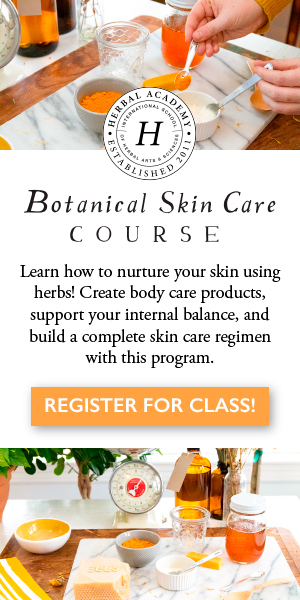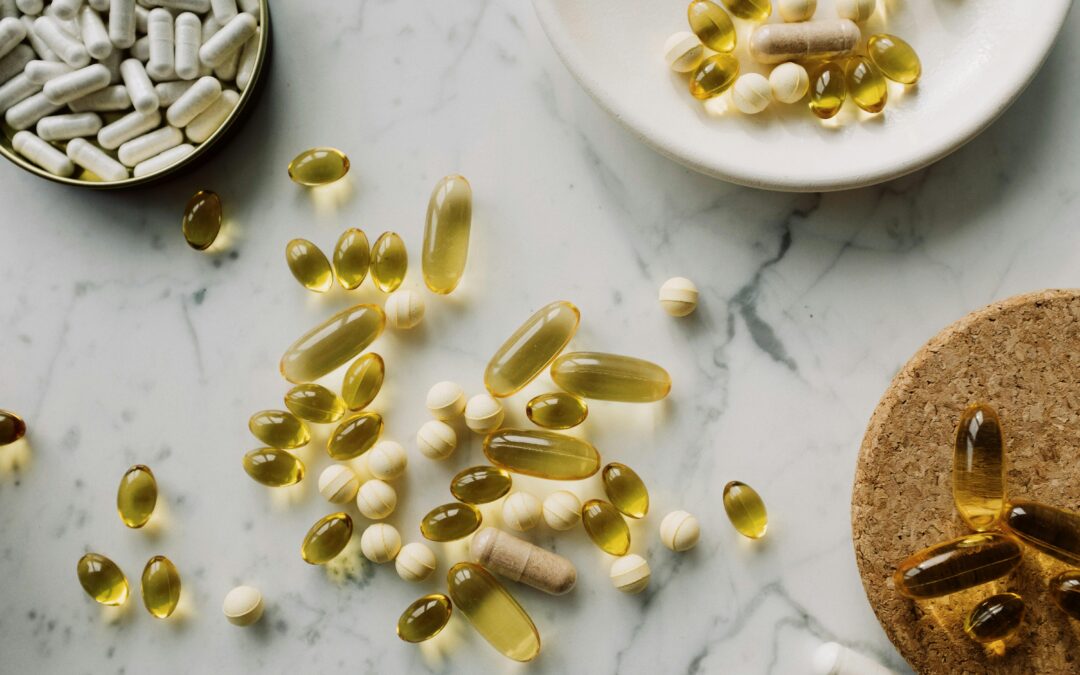
by Leslie Moldenauer | | Vitamins
Is your medicine cabinet overflowing with supplement bottles you had every intention of taking? Have you ever bought supplements out of desperation, hoping for quick relief from stubborn symptoms? The supplement industry can feel overwhelming. Whole Food vs. Synthetic Supplements, proper dosages, and is more actually better? Food-based supplements have a clear edge over their synthetic counterparts, with some key differences between the two. Let’s simplify the confusion and break it all down.
What Is Whole Food-Based Supplements?
Whole food-based supplements are made from concentrated whole food sources, retaining their natural nutrient complexes. They are sources from real food and minimally processed, making them more nutrient dense.
To understand the complexities of this process, we need to understand the plants used to source the nutrients, need to be grown in superior, mineral rich soil, and research shows us that as the years progress the opposite is true.
A landmark 2004 study from researchers at the University of Texas at Austin’s Department of Chemistry and Biochemistry analyzed data from 1950 and 1999 across 43 different vegetables and fruits. The findings revealed “reliable declines” in key nutrients, including protein, calcium, phosphorus, iron, riboflavin (vitamin B2), and vitamin C, over the past half-century. This study is just one of many highlighting the significant depletion of nutrients in our soil. Before choosing a whole food-based supplement, it’s essential to ensure the company prioritizes the health and vitality of the soil where their plants are grown.
Once the plants are grown and harvested, the nutrients are extracted as minimally as possible. The method will depend on the solubility of the nutrient. For example, vitamin B is water soluble whereas vitamin D (technically a hormone) is fat soluble. Dehydration or flash freeing are other ways to extract nutrients from a plant without disrupting its nutritive value. This makes whole food vitamins incredibly nutrient dense and bioavailable, which is great news for you.
Taking this one step further, in order to be certified organic and non-GMO, the standards are much more rigorous.
What Are Synthetic Supplements?
On the flip side, synthetic supplements are created in a lab to mimic naturally occurring vitamins and minerals. These isolated nutrients are often derived from petroleum or other non-food sources. A common example of this is synthetic vitamin C (ascorbic acid), which is derived from genetically modified corn syrup. In contrast, whole food-derived vitamin C comes from natural sources like acerola cherries, where it is accompanied by the cofactor bioflavonoids to aid in its absorption and effectiveness.
Synthetic vitamins are mass produced, come at a lower cost point than their whole food counterparts, and are often available in a higher potency. Remember, higher potency where synthetic is concerned do not equate to better absorption or effectiveness in the body.
Key Differences Between Whole Food and Synthetic Supplements
To restate, the key differences between whole food and synthetic supplements include:
- Bioavailability: Whole food supplements are more bioavailable because the body recognizes and absorbs the nutrients in their natural form. The same cannot be said for synthetic vitamins.
- Nutrient Synergy: Natural co-factors (like enzymes, antioxidants, and phytonutrients) in whole food supplements enhance absorption and act on the body processes exactly as we would expect them to. With synthetics, *these supporting compounds are often absent, creating a big unknown in how the body processes them.
- Dosage: More isn’t always better, regardless of the source. For example, higher doses of vitamin C (a water-soluble vitamin) are excreted through urine if the body doesn’t need them. On the other hand, excessive intake of vitamin A (a fat-soluble vitamin) can build up in the liver and become toxic over time. Key Takeaway: Water-soluble vitamins are excreted in urine when consumed in excess, while fat-soluble vitamins can accumulate in the liver and pose health risks.
- Quality and Source: Not all supplements are created equal. When choosing a supplement, pay close attention to:
-Ingredient Origin: Look for supplements sourced from certified organic farms and clearly labeled as derived from whole food sources (e.g., acerola cherries for vitamin C).
-Manufacturing Standards: Choose brands that follow strict quality control measures and have transparent manufacturing practices (e.g., third-party testing for purity and potency).
-Label Transparency: Avoid vague terms like “proprietary blends” and instead look for specific ingredient listings and sourcing information.
-Certifications: Check for certifications such as USDA Organic, NSF Certified, or GMP (Good Manufacturing Practice).Understanding these differences ensures you’re investing in supplements that not only meet your health goals but also align with your values for quality and sustainability.
Common Myths About Whole Food Supplements
- Myth 1: Whole food supplements are too expensive.
While you may have found that whole food supplements often come with a higher prices tag, their value lies in the superior quality, bioavailability and synergy with our body. Synthetics are cheaper upfront, but when you need higher dosages to achieve similar results, the cost is likely higher over time.
- Myth 2: You don’t need supplements if you eat healthy food.
I know we have all heard this one shouted from the rooftops. The truth of the matter is that while a balanced diet is the building blocks for optimal health, we can now see that modern agricultural practices, soil depletion, and environmental factors means that even the healthiest diets can fall short in essential nutrients.
More isn’t always better. Water-soluble vitamins (e.g., Vitamin C, B vitamins) are generally excreted if taken in excess, while fat-soluble vitamins (e.g., Vitamin A, D, E, K) can accumulate in the liver and become toxic over time. Look for supplements with clinically backed dosages and avoid mega-dosing unless for a very short time or while under the supervision of a healthcare professional.
Choosing the right supplements doesn’t have to be overwhelming. By understanding the differences between whole food and synthetic supplements, reading labels, and choosing trusted brands, you can make informed choices that support your health and well-being.
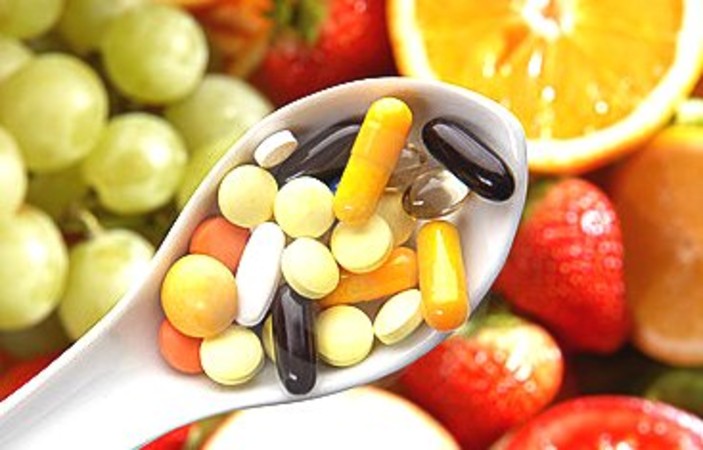
by Leslie Moldenauer | | Food, Vitamins
With so many vitamin brands and choices, choosing vitamins is never an easy process. There are many aspects to consider, I will cover a few of them here: Choosing the best vitamins for your kids.
Is your Vitamin C “Real” or Genetically Modified?
Vitamin C is a powerful ally in our tool chest, as it is a strong antioxidant, and well as good for tissue repair and healing of wounds (Vitamin C does much more, but my focus here is with children). Vitamin C taken in large doses (split up throughout the day) at the first sign of a cold is incredibly helpful for a quicker recovery.
The problem that many are not aware of is that most vitamin C tablets/powders are synthesized in a lab, in a form called ascorbic acid.
Ascorbic acid is synthesized from corn syrup. Over 88% of the corn crops in the US are currently genetically modified. (Source) Therefore, any vitamin C derived from corn syrup is a GM product. The only exception would be if the bottle states that the product is organic and GMO-free. Look for this seal on your bottle:
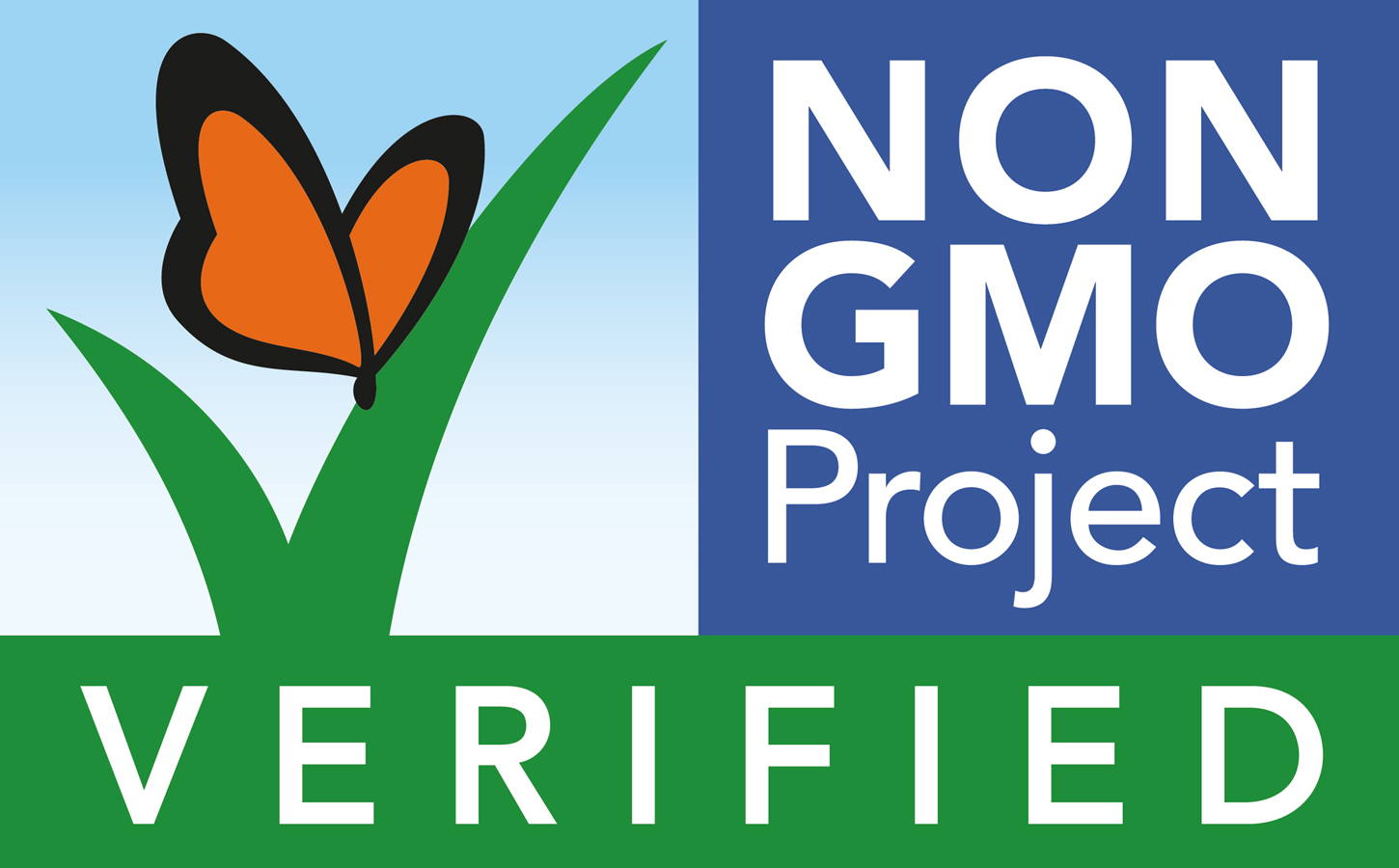
Although it is rare to be “seriously” deficient in vitamin C, evidence still suggests many suffer from a deficiency. (Source)
Here is a link to the vitamin C that my household uses daily. (Source) Available in pill or powder form
Some companies provide vitamin C as ascorbic acid but proudly state not from GM sources. Whole food is best, but is not the only available option.
What is the Difference Between Folate and Folic Acid? Why should you care?
There are many healthcare providers who believe that the two are interchangeable, but they are not. Folate is a group of water-soluble B vitamins, also known as B9. Folic acid is the oxidized synthetic compound used in dietary supplements, folate is the natural form.
Folic acid is not the only synthetic you need to look out for in your children’s vitamins. What is the issue with synthetic vitamins? Synthetic vitamins are made in a lab, with chemicals that do not come from the natural source, (made from whole food). Synthetic vitamins are supposed to mimic the way natural vitamins act in our bodies. Oftentimes, these synthetic isolates cannot be used or even recognized by the body, and here lies a major problem with synthetics (Source). Scientists are not quite sure what exactly happens when consuming synthetics, but one theory is they oxidize quickly in the body.
“The process of oxidation in the human body damages cell membranes and other structures including cellular proteins, lipids, and DNA. When oxygen is metabolized, it creates ‘free radicals’ which steal electrons from other molecules, causing damage” (Source).
Here is a complete list of synthetics to be aware of and avoid:
Vitamin A: Acetate and Palmitate
Vitamin B1 (Thiamine): Thiamine Mononitrate, Thiamine Hydrochloride
Vitamin B2 (Riboflavin): Riboflavin
Pantothenic Acid: Calcium D-Pantothenate
Vitamin B6 (Pyridoxine): Pyridoxine Hydrochloride
Vitamin B12: Cobalamin
PABA (Para-aminobenzoic Acid): Aminobenzoic Acid
Folic Acid: Pteroylglutamic Acid
Choline: Choline Chloride, Choline Bitartrate
Biotin: d-Biotin
Vitamin C (Ascorbic Acid): Ascorbic Acid
Vitamin D: Irradiated Ergosteral, Calciferol
Vitamin E: dl-alpha tocopherol, dl-alpha tocopherol acetate or succinate
NOTE: The “dl” form of any vitamin is synthetic.
(The above list is taken from Source)
One more important thing to mention is that there have been reports of negative effects on children who take supplements containing folic acid during pregnancy. One study showed a possible link to an increase in childhood asthma (Source). Here is a vitamin that I recommend for little kids that can not swallow a pill quite yet, has Non-GMO vitamin C (Source), derived from whole foods and does not contain folic acid.
Vitamins should not be a replacement for proper nutrition, but I fully believe that even when eating a good diet, vitamins may still be necessary. When you take vitamins derived from whole food, they are properly absorbed and assimilated without risk.
Avoid Large Amounts of Vitamin A
Are you aware of the risk that comes with taking large amounts of vitamin A, or any antioxidant for that matter? Although vitamin A is crucial for a child’s health and development, its consumption is not cut and dry. Let me explain.
Currently, the recommended dose of vitamin A for children is as follows:
1-3 years—1,000IU or 300mcg
4-8 years—1,333IU or 400mcg
9-13 years—2,000IU or 600mcg
These are the recommended daily allowance, not the maximum daily allowance. (Source)
If you look up the contents of vitamin A in a food you would see that vitamin A can be obtained easily. Now grab your child’s multivitamin. I would guess it contains 2,500IU of vitamin A, but I have seen some as high as 5,000IU.
Why is this a problem? Unlike vitamin C which is a water-soluble vitamin, vitamin A is a fat-soluble vitamin. When you take excessive amounts of water-soluble vitamin C, your body releases what it does not need in your urine. An excessive amount of vitamin A, however, gets stored in the body, particularly in the body tissues. According to WebMD, “High dose of vitamin A, or any other antioxidant, may do more harm than good and is associated with increased risk or mortality from all causes” (Source). As mentioned above, excessive consumption of any antioxidant actually becomes a pro-oxidant, and this is not favored.
Pay very close attention to the vitamins you are giving your children. Multiple products can contain vitamin A, for example, your multivitamin and cod liver oil if that is something you give to your children. Make efforts to add up the multiple sources.
I believe kids need a multivitamin, but they need one that is not providing everything in excessive amounts. You are feeding your kids the best you can and the vitamin is meant to close the gap. Many believe you can take too much of a good thing.
Another thing to consider….. You may have found vitamins that state that they are derived from whole food and that the recommended dose is not simply one pill, but 3-4 a day. Why is this? If you obtained the daily allowance of the vitamins and nutrients in one pill, the pill would be so large you may not even be able to swallow it! This is another reason for some synthetics. As you can see, there is not a perfect solution with one perfect answer.
Don’t Forget About Herbs
I have a minor in herbalism and am a huge proponent of using herbs at home. It is critical to know what you are getting with herbs as well as vitamins. Many crops are not grown sustainably, are heavily sprayed with pesticides and fertilizers, not fresh or true to the amounts that are shown on the bottle. As there is a multitude of things to keep in mind where herbs are concerned. I make all my own teas, decoctions, infusions, tinctures, etc. It is critical to perform your own research.
Here are a few companies that I utilize, but I do try to grow as much of my own herbs as possible:
Mountain Rose Herbs
Starwest Botanicals
Here are some resources to learn how to DIY:
Rosemary Gladstar
#1
#2
#3
It’s All Medicine
Whether we are talking about vitamins, minerals, herbs, or essential oils, they are all medicine. Little kids should not confuse vitamins with candy. Make sure they understand this from a very young age. I tend to avoid gummy vitamins for this reason (as well as the added sugar) unless I have made them. I have seen blogs showing babies and toddlers holding bottles of essential oils or applying oils themselves (no I am not making that one up). This is not recommended. Please respect it all as medicine, as that is what it truly is.
Remember that even though something is touted as natural, that everything is dose-dependent. The poison is truly in the dose.
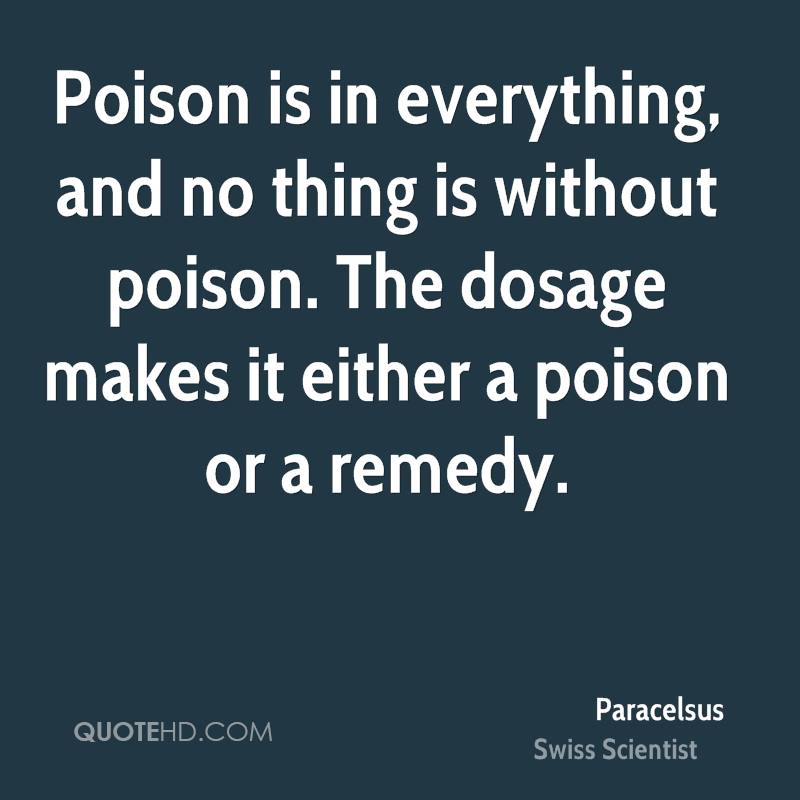
Pediatrician Recommended
I simply could not write this article about vitamins and not talk about this. I find it incredible that the most widely recommended children’s multivitamin, “from prehistoric times” with a popular cartoon from when I grew up is filled with…well…crap! When looking at the label of the #1 PEDIATRICIAN RECOMMENDED CHOICE vitamin, you will find:
Aspartame
Numerous artificial colors (FD & C Blue #2, Red #40, Yellow #6)
Zinc Oxide
Sorbitol
Soybean Oil (GMO)
Corn Starch (GMO)
FULL of synthetics
Quite frankly, a vitamin could not get much worse than this.
Purity and Testing
It is important to do your own research on anything that you purchase. I have provided a few links throughout the article, but this is by no means an exhaustive list. Purity and testing are important, but there are not too many standards out there currently.
One that is relatively new is called USP (US Pharmacopeial Convention). According to their website (Source)
When you see the USP mark, it means the supplement:
Contains the ingredients listed on the label, in the declared strength and amounts
Does not contain harmful levels of specified contaminants
Is made according to FDA and USP Good Manufacturing Practices, using sanitary and well-controlled processes.
This surely is a good start.
Fish oils in any form also need to be researched well for purity and testing. Certain products can contain heavy metals, so it is important to know that your product has been quality tested and that the company stands by what is in their bottle.
In conclusion
We all try to do what is best for our children in every way and making sure that they are getting proper nutrition/nutrients is critical for health and development. I hope that I have helped shed some light on some important issues and have made the selection process a bit easier. Health and light!
*Sources listed within the article

Please note that I am not a medical practitioner. The content of this website is provided for general informational purposes only and is not intended as, nor should it be considered a substitute for, professional medical advice. Do not use the information on this website for diagnosing or treating any medical or health condition. If you have or suspect you have a medical problem, promptly contact your professional healthcare provider. By using this website, you assume full responsibility and liability for your own actions.
BEFORE YOU GO! Remember to sign up for my FREE Facebook group! Hang out with me and THOUSANDS of other Essential Oil lovers looking to learn, click on to join Real Essential Oil Education Group!
Check out my FREE offer below!
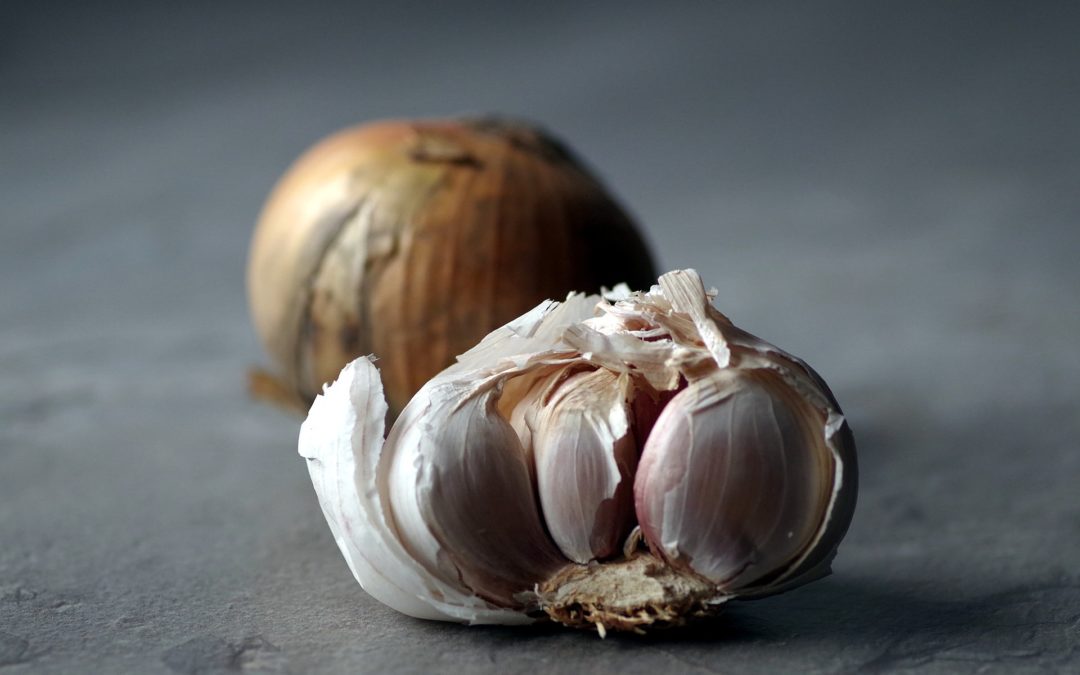
by Leslie Moldenauer | | Herbs, Vitamins
Moms, we are always looking for ways to keep both ourselves and our kids healthy, right? The lists of helpful things available to us are long, and today I want to talk about a few natural ways to boost your immune system. (There are many ways, I will cover my top 10) I am sure we can all agree that there is no good time to get sick. Luckily, there are many things at our disposal that can go a long way to keep our immune system strong and doing its best to kill what we come in contact with on a day to day basis.
#1 Vitamin D-The sun is our friend. Research suggests three-quarters of U.S. teens and adults are deficient in vitamin D… leaving them with less-than-optimal health (1).
Your skin naturally produces your body’s supply of vitamin D from direct exposure to bright midday sun with a mere ten or fifteen minutes’ exposure per day. What is one of the symptoms of low Vitamin D? You guessed it….a greater incidence of cold and flu. Taking a low amount of Vitamin D is perfectly safe if you are not able to get this amount of sunshine a day. It is said that fair skinned individuals, especially redheads, can absorb and utilize Vitamin D much easier than others. Where you live also plays an important part. The closer to the equator you live, the better. Since Vitamin D is is NOT a water soluble vitamin, please be sure to get your Vitamin D levels checked by your doctor before taking large amounts via a supplement.
#2 Eat a healthy diet-It goes without saying that eating healthy will boost your immune system. Eat plenty of vegetables, fruits, nuts, and seeds which will provide your body with the nutrients your immune system needs. Simply put, illness and dis “ease” thrives on sugar. Consuming too much sugar suppresses the immune system cells responsible for attacking bacteria.
#3 Probiotics– Probiotics are a form of healthy gut bacteria. Their job it to stimulate naturally forming enzymes in the gut to keep out digestive system happy and healthy, and to keep us well. Keep your gut flora in check and in good balance by consuming plenty of fermented foods or by taking a quality daily supplement.
#4 Echinacea– Echinacea stimulates the body to produce more infection-fighting white blood cells, such as T-lymphocytes and killer white blood cells. Echinacea also seems to search out and destroy some viruses, such as the common cold and flu viruses. There have been many studies performed on echinacea with mixed results. Some say that echinacea should be used periodically as a preventative, others say use echinacea when you get sick. Do some research for yourself!
*Echinacea is NOT for you if you have an autoimmune condition such as lupus, rheumatoid arthritis, or diabetes. I recommend taking it for no more than 2-4 weeks, respectively, without taking a break.
Read more on echinacea here.
#5 Ginger-One of my FAVORITE herbs. (Technically a root) Ayurvedic medicine believes that ginger helps to cleanse the lymphatic system, which is our body’s sewage system (2). By helping keep your airways and lymphatics open, ginger may help prevent the accumulation of the toxins that may increase your risk of infection. (It may help with aches and pains too!)
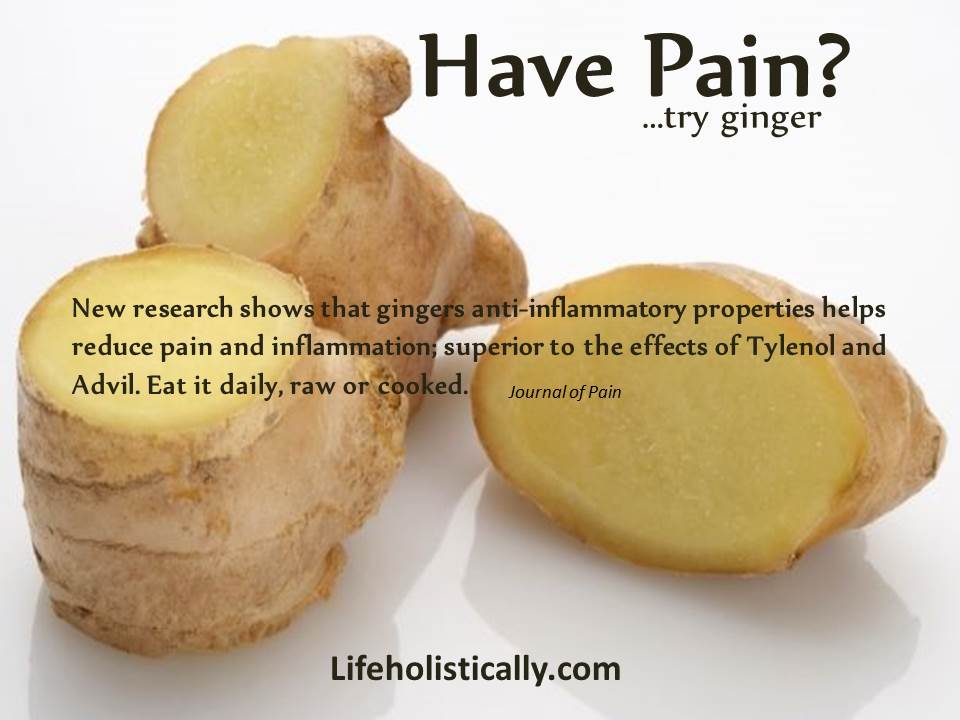
*There are contraindications to using ginger. Do not take ginger if you use anticoagulants, have gallstones, or a clotting disorder (3).
#6 Garlic-Cook with it often, raw is best (although you might not be holding many conversations afterwards) Allicin, the primary active constituent of garlic has been used to prevent colds and flu. There is truth to grandma’s chicken soup! Garlic is also a natural antibiotic, and can help fight off infection before it sets in (4). Crush the garlic bulb on the counter and let sit for 10 minutes before adding it you your meals (or eating raw) to release this potent compound. If using in cooking add at the later part of the cooking process to retain this powerful constituent.
*Do not use is you take anticoagulants of have liver problems. Garlic can cause gastrointestinal discomfort in some people or in excess.
#7 Elderberry Syrup– Used for its antioxidant activity, boosting the immune system, and is great for coughs, colds, and flu, elderberry syrup is a must have in your home. There is research to back up this powerful little berry, here is one study on PubMed. Elderberries contain amino acids, carotenoids, flavonoids, vitamins A and B and a large amount of vitamin C. They are also mildly laxative, a diuretic, and diaphoretic. Flavonoids, including quercetin, are believed to account for the therapeutic actions of the elderberry flowers and berries.
Here are some additional studies that speak to the benefits of elderberry. You can purchase at your local CVS, Walgreens, or buy on Amazon. I prefer to make my own.
*Kong F. Pilot clinical study on a proprietary elderberry extract: efficacy in addressing influenza symptoms. Online Journal of Pharmacology and Pharmacokinetics. 2009;5:32-43.
*Roschek B, Fink RC, McMichael MD, et al. Elderberry flavonoids bind to and prevent H1N1 infection in vitro. Phytochemistry. 2009;70:1255-61.
*Ulbricht C, Basch E, Cheung L, et al. An evidence-based systematic review of elderberry and elderflower(Sambucus nigra) by the Natural Standard Research Collaboration. J Diet Suppl. 2014;11(1):80-120.
*Zakay-Rones Z, Thom E, Wollan T, Wadstein J. Randomized study of the efficacy and safety of oral elderberry extract in the treatment of influenza A and B virus infections. J Int Med Res. 2004;32:132-40.
#8 Sleep-Something that even I struggle with. Not due to insomnia, (I consider myself very lucky) but due to being a Mom of two small children and a full time student. I often burn the candle at both ends. I do my best to get minimum of 7 hours of sleep, 7-9 is ideal. Fatigue increases your susceptibility to illness. Like stress, insomnia can cause a rise in inflammation – and similarly an increase in cortisol-your stress hormone. The higher your stress, the weaker your immune system gets.
#9–Yoga, meditation, and other relaxation techniques– If stress suppresses the immune system, then practices that suppress stress boosts your body’s ability to heal itself! Lowering levels of cortisol in the blood can improve sleep, boost the immune system, and keep your endocrine system chill, which then in turn helps fight for your overall health and well-being. This can easily be achieved by meditation or other relaxation techniques such as yoga, tai chi, qigong, progressive muscle relaxation, etc. I say easily in that all of these rituals will work wonders, but it is you that has to follow through. Not always easy in our busy world…but keep doing your best! Embrace as may self-care items into your everyday routine as possible for optimal health.
#10–Happiness– Last but not least: laughs, hugs, and overall happiness. Laughing decreases the amount of stress hormones in the body while increasing a type of white blood cell that fights infection (5). Hugs strengthen the immune system as well. Hugs, and good happy feelings in general stimulates the thymus gland, which regulates and balances the body’s production of white blood cells. Hug multiple times a day for best results. Smile….be happy!

References
(1) Demographic Differences and Trends of Vitamin D Insufficiency in the US Population, 1988-2004. Retrieved from
https://jamanetwork.com/journals/jamainternalmedicine/fullarticle/414878
(2) (3) Ginger: The Ayurvedic Perspective. Retrieved from http://www.muditainstitute.com/blogs/happybelly/ginger.html
(4) Garlic: Proven Health Benefits. Retrieved from https://www.medicalnewstoday.com/articles/265853.php
(5) Why Laughter Is Good For The Immune System, Opens Inner Cellular Pharmacy. Retrieved from http://www.laughteronlineuniversity.com/laughter-immune-system/

Please note that I am not a medical practitioner. The content of this website is provided for general informational purposes only and is not intended as, nor should it be considered a substitute for, professional medical advice. Do not use the information on this website for diagnosing or treating any medical or health condition. If you have or suspect you have a medical problem, promptly contact your professional healthcare provider. By using this website, you assume full responsibility and liability for your own actions.
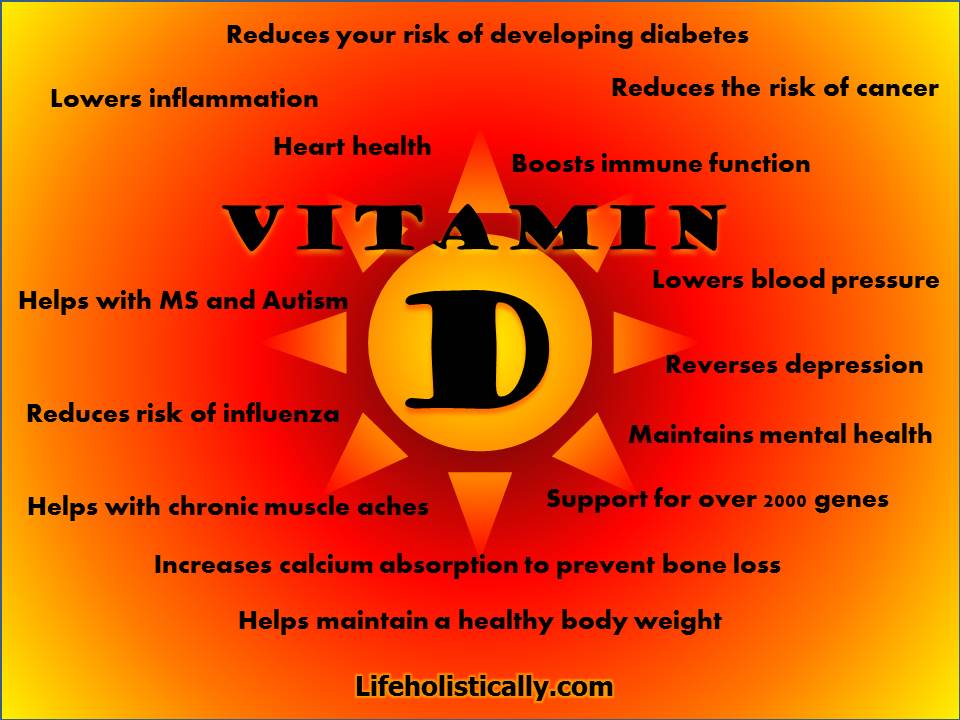
by Leslie Moldenauer | | Vitamins
I am not one to take handfuls of vitamins, I fully believe in getting your nutrition from food first. That is a tough job, with soil depletion alone, foods are not nearly as full of vitamins and minerals as they were even 20 years ago. That being said, I still eat as close to 100% organic as possible. I drink smoothies, I juice vegetables, eat only grass fed organic meats, and eat as little grains and dairy as possible. There are not many foods rich in vitamin D. I eat next to no dairy, limited eggs, and fish only once or twice a week. EVEN IF I ate those things every day, I would not get enough vitamin D. You simply can’t get it by diet alone. Therefore, the #1 supplement I am sure to take, is Vitamin D3.
Vitamin D3
The sun is our friend. Research suggests that up to 85% of people could be deficient in vitamin D without knowing it… leaving them with less-than-optimal health. Vitamin D is responsible for the regulation of over 2,000 genes in your body!
Your skin naturally produces your body’s supply of vitamin D from direct exposure to bright midday sun with a mere ten or fifteen minutes’ exposure per day. From everything we have been told the sun is not our friend and we need to slather ourselves with toxic sunscreen to avoid skin cancer. This is not the answer. You NEED the sun EVERY DAY in order to get optimal Vitamin D levels. What is the #1 cause of skin cancer? You guessed it, LOW Vitamin D levels. So if your putting on sunscreen, you are sure to be low in vitamin D. If you live above the equator, in the winter you are getting no Vitamin D from the sun whatsoever. You see the theme here? Everyone should be supplementing with vitamin D, and in my opinion be sure to get some sun every day without the use of sunscreen. When you do use sunscreen, please research the safest ones, the vast majority of sunscreens found in stores is not safe for your health.
Not sold yet?
Here are the symptoms of low vitamin D levels:
- Fatigue
- General muscle pain and weakness
- Muscle cramps
- Joint pain
- Chronic pain
- Weight gain
- High blood pressure
- Restless sleep
- Poor concentration
- Headaches
- Bladder problems
- Constipation or diarrhea
- Depression or “winter blues” (no sun anyone)?
- Frequent colds
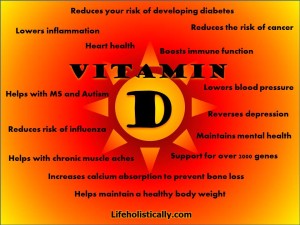
Click image for full size
How about the diseases associated with low vitamin D levels:
- Osteoporosis and Osteopenia
- 17 varieties of Cancer (including breast, prostate and colon)
- Heart disease
- High blood pressure
- Obesity
- Metabolic Syndrome and Diabetes
- Autoimmune diseases
- Multiple sclerosis
- Rheumatoid arthritis
- Osteoarthritis
- Bursitis
- Gout
- Infertility and PMS
- Parkinson’s Disease
- Depression and Seasonal Affective Disorder
- Alzheimer’s Disease
- Chronic fatigue syndrome
- Fibromyalgia
- Chronic Pain
- Periodontal disease
- Psoriasis (1)
I recommend that if you suspect that your levels are low that you get them tested. Your primary doctor can do this for you, no specialty needed. You can go ahead and take the recommended dosages that I am giving you from Dr. Mercola’s website, but make note**** I tested on the low end of the scale when I was taking 4,000IU every day and have since then begun taking quite a bit more. Currently I take approximately 7,000IU every day, my kids get 2,000IU (5 and 7). If I feel like I am coming down with a cold or am sick we take more. Now if it is summertime, we are outside quite a bit and might not take any at all.
As a general rule of thumb, older people need more than young people, big people need more that little people, larger people need more than smaller people, northern people need more than southern people, dark-skinned people need more than fair skinned people, winter people need more than summer people, sun block lovers need more than sun block haters, sun-phobes need more than sun worshipers, and ill people may need more than well people.-Dr. Frank Lipman
The chart below is from Dr. Mercola’s website. He is a wealth of information on Vitamin D.
|
VITAMIN D DOSE RECOMMENDATIONS
|
| AGE |
DOSAGE |
| Below 5 |
35 units per pound per day |
| Age 5 – 10 |
2500 units |
| Adults |
4000-8000 units |
| Pregnant Women |
5000-10000 units |
| WARNING: There is no way to know if the above recommendations are correct. The ONLY way to know is to test your blood. You might need four to five times the amount recommended above. Ideally, your blood level of 25(OH)D should be 60ng/ml. |
So are you thinking what if I take too much? Rest assured that Vitamin D toxicity is unheard of at these lower levels. Dr. Mercola emphasizes that “under summer conditions it is frequently possible to generate about 20,000 units of vitamin D by exposing your skin to the sun. That fact makes these recommendations seem more in line with reality”.
The OPTIMAL value that you’re looking for is 50-70 ng/ml. (2)
Having optimal vitamin D levels may slash your risk of all cancers by 77% and breast cancer by 90%. (3) This alone is reason for me to monitor my levels. You should too!
Resources
http://www.drfranklipman.com/symptoms-diseases-associated-with-vitamin-d-deficiency/
http://articles.mercola.com/sites/articles/archive/2009/10/10/vitamin-d-experts-reveal-the-truth.aspx
http://articles.mercola.com/sites/articles/archive/2013/05/12/vitamin-d-may-prevent-breast-cancer.aspx
Please note that I am not a medical practitioner. The content of this website is provided for general informational purposes only and is not intended as, nor should it be considered a substitute for, professional medical advice. Do not use the information on this website for diagnosing or treating any medical or health condition. If you have or suspect you have a medical problem, promptly contact your professional healthcare provider. By using this website, you assume full responsibility and liability for your own actions.















